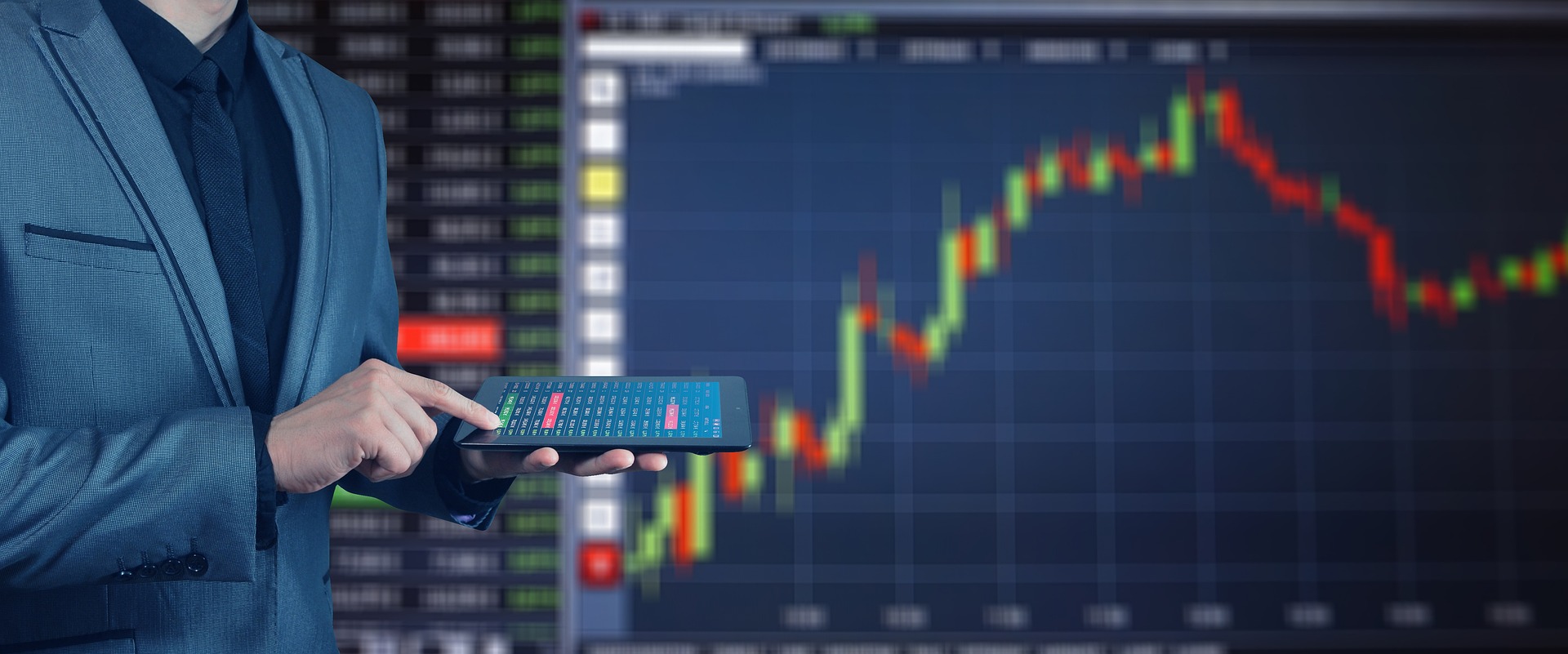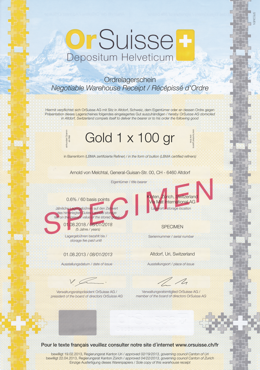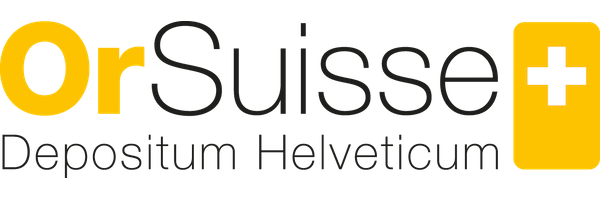Comparison of OrSuisse negotiable warehouse receipts vs precious metal ETFs
Further information » Product Comparison: Physical Precious Metals vs Gold ETFs
Comparison of negotiable warehouse receipts and precious metal ETFs at a glance:
- 10 minutes read
What are the advantages and disadvantages of precious metal investment funds compared to physical gold or silver holdings with tradeable warehouse receipts?
Gold or silver investment can take various forms. In addition to physical bars or coins, it’s also possible to make a virtual investment in precious metal ETFs, with funds available from many Swiss banks. Alternatively, you could combine both these elements using OrSuisse tradeable warehouse receipts. But what is the likely potential of these different investment formats?
Regardless of the chosen format, a precious metals investment offers real potential for diversification within an investment portfolio. In addition to long-term asset accumulation, gold or silver investments can also serve to offset losses in other asset classes. They are often used as a hedge against inflation, or perhaps to support retirement planning. Precious metals are generally in particular demand in times of geopolitical crisis as a means of securing capital. Gold is nicknamed the ‘crisis metal’ and, thanks to its reputation for stability, is considered a safe haven in turbulent times.
As a would-be investor, whether you prefer to invest your capital in physical precious metals or in ETFs is essentially down to your personal needs, coupled with your expectations for each respective investment class. It is also crucial to consider how much time you can devote to your investments, and how flexibly you can, or would wish to, react to constantly changing markets. You can find out more about these two modes of precious metal investment and their advantages and disadvantages in the following sections.

What are ETFs?
The abbreviation ‘ETF’ stands for the technical term “Exchange Traded Fund”. Precious metal ETFs are a special form of investment fund, usually consisting of gold or silver ETFs. Funds based on the price of other precious metals such as platinum or palladium are less likely to be available.
By purchasing gold or silver funds, investors can directly participate in ongoing price developments in the precious metal markets. However, such investors only acquire physical metal indirectly via a share allocation. Dividends are usually paid in the respective national currency, in Swiss francs, euros or British pounds, for example. Nevertheless, this paper gold is at least partially backed by real gold assets. However, these are mostly large bar units of 400 ounces (12.4 kg, worth around CHF 700,000), so – depending on the precise amount of remuneration you anticipate – redemption in gold is not really a practical possibility. And likewise with silver ETFs; deposits are typically in standard bars weighing 1000 ounces (equivalent to approximately 31 kg). Some precious metal ETFs even explicitly exclude any delivery of precious metals.
Stock exchange trading in precious metal funds is carried out by brokers who are paid a commission for their services. Investors can manage their investments with little effort and can decide to sell their digital gold or silver shares at any time – even at short notice. You can find out more about the pros and cons of ETFs in the section below.
What are negotiable warehouse receipts?
Investors who store their physical precious metals in Switzerland with OrSuisse receive tradeable warehouse receipts for their gold or silver holdings. These negotiable order warehouse receipts are classified as securities under the Swiss Code of Obligations. This status demands the approval of the governing authority of the Swiss canton in question. One special feature of negotiable warehouse receipts is that transfers of ownership can be easily implemented by means of an integrated endorsement section. This effectively means precious metals can be sold or assigned as a security without the need for any physical movement of goods to take place.
Negotiable warehouse receipts are precisely matched to the deposited precious metals. They can be used for bars or coins made of gold, silver, platinum or palladium. Up to ten products of any one type of metal and denomination can be entered on each individual warehouse receipt. You can find more detailed information about negotiable warehouse receipts here.

Secure and discreet storage of precious metals takes place in purpose-built high-security facilities in Switzerland, with full insurance protection. Instead of the usual collective storage, client inventory is stored individually. This ensures the original coins or bars deposited in storage will always remain the property of the client. And for investment holdings of silver, platinum or palladium, OrSuisse also provides segregated storage in a duty-free warehouse. This means, in addition, that these white metals can be purchased free of VAT levies. Learn more about the other advantages of individual storage in combination with negotiable warehouse receipts in the section below.
Advice or questions? Please contact us
The gold orsilver price as the common feature
Whether your acquisition consists of physical precious metals or paper gold, both these asset classes use precious metal prices to determine their value. This applies equally to their acquisition as well as to their subsequent sale. The price of gold or silver, always quoted based on one troy ounce (31,103 grams), is negotiated on international markets every day of the week. The London Bullion Market in Great Britain is considered one of the largest over-the-counter trading venues. The spot price is initially quoted in US dollars and then converted and subsequently expressed in each respective national currency according to the current exchange rate.
When precious metal coins or bars are purchased, a surcharge is added to reflect the manufacturing costs and the dealer’s profit margin. The resultant premiums for coins are generally higher than those charged for bars. Gold investments are exempt from VAT. However, the purchase of white metals is subject to VAT (but silver stored in a duty-free warehouse is one important exception). The purchase prices of ETFs incorporate the precious metal market price, plus a surcharge, broker commission and perhaps (depending on the country) stock-exchange taxes.
The advantages and disadvantages of precious metal ETFs
The biggest advantage of precious metal ETFs is certainly the high flexibility of this asset class. The funds can be easily sold via a broker at any time during normal market hours. This makes gold ETFs especially suitable for short-term trading. Investors can invest virtually any amount in precious-metal-backed funds, with one unit corresponding to one single gram of gold or silver. And because gold and silver funds are only traded in a digital environment, there is no physical risk of theft. However, as with any digital format, there remains the ever present risk of hacker attacks or server issues.
Despite the advantages paper gold investments can offer, the disadvantages cannot be ignored. Anyone who purchases precious metal ETFs does not actually own the physical metal. The ETF provider may only hold a proportion of physical precious metals to secure its assets – relying on ‘paper gold’, for example, to cover the rest. This practice assumes few investors actually want their profits to be paid out in physical gold or silver rather than cash. Furthermore, there is often no obligation on the part of the provider to provide any redemption at all in kind. Details can be found in the respective fund prospectus, or in the provider’s general terms and conditions (GTC).
The cost factor should also be carefully considered. One element is the ETF maintenance costs. These are usually deducted from the fund assets on an ongoing basis and range between 0.4-1% per year. In addition, there are the costs associated with the customer’s deposit with the bank or broker. Such costs can be low, but often amount to an additional 0.4% per year, or even more.
Where investors commission an asset manager to buy in precious metal ETFs on behalf of their portfolio, the appropriate asset management costs will also be added to the costs mentioned above. These could amount to anything between an additional 0.5-2.5% additional per year, depending on your agreement with the asset manager.
Furthermore, a fund provider’s general terms and conditions often state that share repayments can be temporarily postponed. Such a case can occur if international precious metal trading is suspended, restricted or even closed down. This could occur, for example, in response to geopolitical, economic or military emergencies. A general restriction on foreign exchange transactions may also temporarily delay a payout. In addition, many brokers also reserve the right to withhold distributions if too many shares are called in at the same time where this could potentially affect the overall investment.
Furthermore, precious metal funds may expose investors to the risk of a counterparty default. The bank or broker provider could be directly or indirectly affected by bankruptcy. In this event, a (partial) loss of the core investment must be expected. Miscalculation of costs for transactions or fund administration may also occur, and lead to further unplanned losses. Due to the rather speculative nature of ETF products, there is also the risk of a certain volatility (price fluctuation). For example, the price of gold can sometimes reach a daily high of 2,000 Swiss francs, before falling back to its previous lower level.
Advantages of precious metal ETFs | Disadvantages of precious metal ETFs |
+ Quick conversion to cash. + No shipping fees. + No storage costs. + No physical risk of theft. | – Mostly no title/ownership or claim to physical precious metal. – High costs. – Risk of postponed payment at times of crisis. – Possible counterparty risk. – Risk of incurred loss due to administrative errors. – Digital assets are vulnerable to hacking and server failures. |
Conclusion: Precious metal ETFs are particularly suitable for experienced, risk-taking investors who are looking for short-term investments in gold or white metals.
The advantages and disadvantages of storing precious metals at OrSuisse
The alternative to gold or silver funds is an investment in physical precious metals with subsequent storage at OrSuisse, and including access to tradeable warehouse receipts. This form of investment secures 100% ownership of precious metals. Clients can store their gold in Switzerland and also receive negotiable warehouse receipts for their bars or coins. The same applies to silver, platinum and palladium investments, which can be stored in a duty-free warehouse free of VAT. Whether you choose a domestic or bonded warehouse, segregated storage can be implemented entirely independent of the banking system. The stored goods are also fully insured, which addresses any risk of theft, loss or damage.
Negotiable warehouse receipts can be transferred and sold at any time via a simple endorsement. For example, duty-free silver stocks can be transferred quickly and easily, thus avoiding the customary high differential between the buying and selling price, and all without incurring a VAT levy. Via another innovative option, negotiable warehouse receipts for gold investments can also serve as security to obtain a loan, or for other financing purposes. Receipt documentation is created under strict security provisions by the highly-respected Giesecke & Devrient company, the world’s largest printers of currency and securities.
Clients can also arrange to retrieve their precious metals in the original denominations at short notice. This is guaranteed because the documentation records all the original bar or seal numbers. This means gold or silver investments can be clearly assigned and always remain the property of the warehouse receipt holder.
In recognition of the fact that physical precious metal investments are long-term investments, OrSuisse storage fees can be paid for up to ten years in advance – a feature which allows owners to benefit from consistent pricing. In the event of an early retrieval or the termination of storage arrangements, the advance storage fees paid for complete unexpired years will be reimbursed. Further details can be accessed via our OrSuisse FAQ.
OrSuisse negotiable warehouse receipts thus offer all the advantages of ETFs, with comparatively few disadvantages. The documentation’s uncomplicated transferability renders precious metal holdings maximally fungible and increases their flexible deployment in international trade. And most important of all: investors hold real precious metal, not share certificates.
Advantages of OrSuisse precious metal storage | Disadvantages of OrSuisse precious metal storage |
+ True ownership of physical precious metal. + Segregated storage of original holdings. + VAT-free storage of white metals in a duty-free warehouse. + Low storage fees. + Bank independent, fully-insured storage. + Retrieval available at short notice. + Includes negotiable warehouse receipts. + Easy precious metal transfers via negotiable warehouse receipts – even without a movement of goods. | – Shipping/delivery and storage required. |
Conclusion: Physical precious metal storage with negotiable warehouse receipts from OrSuisse is suitable for long-term wealth creation, and can even be used by novice investors.
Advice or questions? Please contact us
Comparison of negotiable warehouse receipts and precious metal ETFs at a glance:
- Prospective precious metal investors have the choice between gold/silver funds, or physical gold/silver holdings including OrSuisse tradeable warehouse receipts.
- Precious metal ETFs are suitable for short-term investments and can be resold quickly when required.
- Nevertheless, precious metal ETFs have several risks and disadvantages, such as a lack of entitlement to non-cash redemption, or restrictions on payouts.
- When physical precious metals are stored at OrSuisse, the assets permanently remain the property of the warehouse receipt holder.
- Gold is stored in a domestic warehouse, and white metals can be stored in a duty-free warehouse free of VAT. Segregated storage options are available in both Switzerland and Singapore.
- Storage is entirely bank-independent and includes full all-risks insurance.
- Thanks to OrSuisse’s negotiable warehouse receipts, which qualify as securities, physical precious metals can be used just as flexibly as ETFs, without any risk to your precious metal funds.
